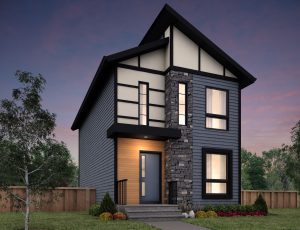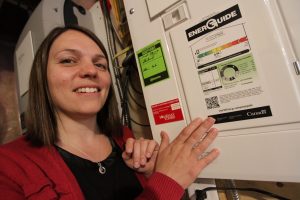By David Dodge & Dylan Thompson
Welcome to the future, a time when your home is energy self sufficient, very comfortable and produces almost no utility bills.
Landmark Homes of Edmonton, Alberta has announced one of the lowest-priced net-zero homes in Canada. The Pisa sells for $399,737 all in (incl. GST), a real breakthrough in the evolution of buildings that produce all their own energy on a net-annual basis.

At under $400,000 the Landmark Pisa model home is one of the most affordable net-zero homes in Canada.
The launch of their new Pisa model show home even attracted Edmonton mayor Don Iveson, and Nathan Stone, second vice president of the Canadian Home Builders Association, along with a host of dignitaries and media.
This new price point means the goal of making all new homes net-zero by 2030 is now a practical potential reality. Not a bad idea since Edmonton is the most northern big city in the Western Hemisphere.
Landmark Homes has already built 25-30 net-zero homes and company founder Reza Nasseri has long had his eye on making net-zero affordable. He’s a process engineer who started building homes in a partially-automated Edmonton factory years ago. Using a process called panelization, workers and robots built a home in one day with almost no waste, at very low energy cost and to exceedingly high levels of tolerance.
Nasseri is also very committed to the environment. “Climate change is an evil that we must deal with,” Nasseri told Green Energy Futures the first time we interviewed him years ago.
Anatomy of an affordable net-zero home

Tanya Rumak, Landmark Group’s sustainability manager shows off her Landmark’s first “0” Gigajoule EnerGuide sticker. The new EnerGuide labels report the energy used by the building and in the case of this affordable net-zero home the annual net energy use is “0”. Photo David Dodge, GreenEnergyFutures.ca
With plenty of natural light and its own garage, The Pisa is a beautiful 2-storey, 1230 sq. foot home built to specifications well beyond the building code.
Leading a tour of the home, Tanya Rumak, Landmark’s sustainability manager, places her hand on the basement floor and suggests we do the same. It’s warm to the touch. One eager gentleman pipes in “Ooh, underfloor heating.”
Rumak shakes her head with a smile, “insulation under the floor.” Yup, foam insulation encases the home.
“We have an R80 attic insulation. We have an R27 above grade exterior wall, and that includes exterior rigid insulation that minimizes thermal bridging. And in the basement, we have R36, which is a fiberglass and mineral wool combination. And then underneath the basement floor, we have two inches of insulation which is R8,” explains Rumak.
Saving heat from the air and water
All that insulation does a great job of keeping heat and air from leaking. The building is so tight it allows only 0.81 air exchanges per hour during a blower-door test. A code-built home would have about 2.5 air exchanges per hour and an older home could have anywhere from four to seven. Don’t worry, though. There’s still plenty of fresh air in the house.
“There are high efficiency heat recovery and ventilation systems,” says Bijan Mannani President of Landmark Homes Canada. To provide fresh air the home uses a heat recovery ventilator that recovers 75 per cent of the heat in the air before exhausting stale air outside.
A similar system recovers heat from your water as it exits the home.
“As you’re showering hot water goes down the drain, you’re literally sending money down the drain.” The solution is heat-recovering copper tubes that retain up to 15 degrees C from hot water going down the drain.
The Pisa is so efficient it requires 60 per cent less energy than a code-built home. In fact, it doesn’t even need gas for heating.
Solar powered, self sufficient and only one utility

The Landmark Pisa model home is a breakthrough for affordable net-zero homes. With no gas connection, the only energy bill you will receive is for electricity and that bill will feature a credit for more than half the year. Photo Landmark Homes
“We don’t have gas coming to this home. This is an electrically-powered home that is run off the solar panels on the roof,” says Rumak.
The heat-pump furnace, heat-pump hot water heater and ventilation system all run on solar power. So no gas bill and no related fixed-distribution administration charges.
The only bill you get is a power bill. “For the majority of that year, you may actually even be running on credits, which means you’re not paying anything. But there may be those few months out of the year in the winter where you have a small bill,” says Rumak.
A net-zero home has no drafts, no cold spots, is super quiet and very comfortable. And there is another kind of comfort. “It’s the comfort of mind that I’m talking about, not having to worry about what’s going happen to my bill next month,” says Mananni.
Affordable net-zero could change the market

Bijan Mananni, the President of Landmark Homes shows off the hybrid heat-pump/water heater this is not just energy efficient, it also runs on electricity provided by the home’s solar system. Photo David Dodge, GreenEnergyFutures.ca
“To me we are reaching the next phase of market transformation, beyond the keeners. We think these homes can be adopted by the masses, driven by affordability,” says Rumak.
It seems pretty clear affordable net-zero could be disruptive to the marketplace. At the pre-opening event I saw retired couples looking to downsize to a net-zero home. They seemed to like the idea of insulating themselves from the cost of utilities.
Then there were professionals and early adopters keen to have a net-zero home and all the latest cool features to show off.
Then there was my wife Monette. She accompanied me to see affordable net-zero in person. She simply said “We should buy one.” She has always been one to cut to the chase and get to the ultimate solution while I geek out over smart thermostats and air-source heat pumps.
The timing of Landmark’s affordable net-zero couldn’t be better. Edmonton announced just a few months ago that work was beginning on Blatchford, the city’s carbon-neutral neighbourhood, that will someday be home to 30,000 people.
[soundcloud url=”https://api.soundcloud.com/tracks/318203751″ params=”color=ff5500&auto_play=false&hide_related=false&show_comments=true&show_user=true&show_reposts=false” width=”100%” height=”166″ iframe=”true”/]About 75 per cent of this potentially world-class sustainable neighbourhood could achieve its goals using affordable net-zero homes. As it turns out town homes are actually an economic sweet spot for net-zero homes.
The price difference between a standard Landmark home and the net-zero home is not that much. The choice could be as simple as choosing a 1,200 sq. foot net-zero home or a slightly larger 1,500 sq. foot home for close to the same price. But only one model has its utilities paid for life!


